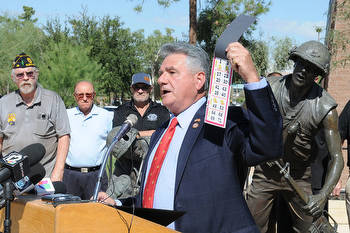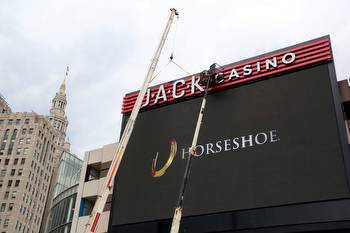Ohio's newest way to gamble: Electronic instant bingo

CINCINNATI — Ohio launched a new form of gambling April 1. Mark Rizzo claimed two jackpots by April 3.
“Saturday I won $500 and Sunday I won $400,” said Rizzo, a State Farm Insurance agent and proud member of VFW Post 6069 in Lebanon. “It’s money for the charities, so it beats going to the casino where they give nothing.”
The Lebanon post is one of about 900 veteran and fraternal organizations now eligible to be licensed for e-Bingo, an electronic gaming platform authorized by an amendment to the state budget bill last June. The amendment ended a nine-year legal fight over the legality of electronic gaming devices. It also could triple the number of devices in play at Moose Lodges, Amvets posts and VFW halls like the Lebanon canteen that Rizzo frequents.
“It’s a pretty substantial expansion,” said Derek Longmeier, executive director of the Problem Gambling Network of Ohio. “The more opportunity there is to gamble in Ohio, the more Ohioans who will gamble and the more Ohioans who will be impacted.”
Gambling addiction won’t be a problem for the five new machines operating at 15 W Silver Street in Lebanon, said Mike Milam, a Navy veteran who keeps the books for the 200-member post.
Milam prefers to emphasize the $33,000 his post donated to charity in 2021.
“Without the charitable gaming, fraternal orders would basically go out of business,” Milam said. “Our big thing around here is, when you play we all win. Whether it’s the (paper bingo pull) tickets or the machines, every dollar you play supports the post. And we get basically 25 cents out of every dollar.”
The big picture
The WCPO 9 I-Team is covering the expansion of gambling in Ohio because it will make state-sanctioned betting available in thousands of new locations and millions of smart phones in the next 12 months. Beyond the 9,000 new gaming machines now possible through e-Bingo, the Ohio Lottery aims to make 2,500 sports-betting kiosks available in bars and restaurants by Jan. 1, 2023. And the Ohio Casino Control Commission is writing the rules that will allow 25 online operators to partner with or compete against 40 retail, or brick-and-mortar sports books.
Charitable gaming was only a 2% slice of the $27.6 billion pie that was Ohio’s legal gambling market in 2021. Slot machines and video lottery terminals swallowed 78% of all the dollars bet last year, with $12.8 billion wagered in the state’s seven racinos and $8.6 billion shared among Ohio’s four casinos. When Ohio’s sports betting market fully develops, experts predict it will claim anywhere from $3 billion to $12 billion in annual wagers.
Will those bets boost the market to more than $30 billion? Or will gamblers cut back on slots and lottery games cover their sports bets? And what impact will these changes have on gambling addiction in Ohio? A 2017 study by the Ohio Department of Mental Health estimated the number of at-risk and problem gamblers doubled after casinos and racinos opened between 2012 and 2014. Will that happen again with this expansion?
Such questions were brushed off as irrelevant at the Lebanon VFW post, where members played pull tabs and demonstrated the new machines for WCPO’s camera.
“If we saw someone getting carried away and spending their rent money on the machines, it’s not too hard to recognize these things,” Milam said. “With this group, somebody’ll say something about it.”
How we got here
Charitable bingo has been legal in Ohio since 1976, but most veteran and fraternal organizations used paper pull-tab games before 2011, when the Ohio Veterans and Fraternal Charitable Coalition signed a contract with a Columbus company to install electronic raffle games at veterans posts statewide. That put veterans in direct competition with casinos and racinos, which opened gradually between 2012 and 2014.
In 2013, then Ohio Attorney General Mike DeWine ordered electronic raffle games to be shut down, saying they were slot machines, legal only in casinos. Veteran groups quickly won an injunction to prevent the shutdown, sparking a court fight that lasted until January. The Ohio Supreme Court finally dismissed the case as the Ohio Attorney General’s office rolled out a new regulatory framework for e-Bingo.
“On the old machines, we used to have the wheels and so forth, more similar to what’s at the casinos,” Milam said. The new machines “are electronic pull tabs, they call it. They’re supposed to be the electronic version of the pop tickets where you would of course buy at bingo.”
The new games debuted to mixed reviews at Milam’s VFW post. Some members complained they’re harder to win. Others said the machines froze. Milam said his vendor told him a software fix was in the works, slowed by a regulatory review required by the Attorney General’s office.
Milam is relieved the legal issue is resolved. But he’s annoyed that the games came with new restrictions, including one rule that makes him ineligible to play.
“The casinos and the government have cracked down on us to make it harder to do the charitable giving,” he said. “People are still playing them at our post, but it’s hard to say if it’ll work. I’ll know in more in six months.”
Gambling expansion?
Also an open question: How big will e-Bingo be in Ohio?
“We haven’t made those calculations,” said Marc Downing, general counsel for Grover Gaming, one of three companies licensed to manufacture and distribute e-Bingo games in Ohio. “By the end of the day, we’ll have over 200 locations installed and active and we expect to have 1,200 electronic bingo devices installed and active.”
Downing said Ohio had three companies competing in this market before last year. The Ohio Attorney General’s office has licensed six companies as manufacturers or distributors, with three applications pending. Competition is already fierce. Milam said Grover Gaming changed its pricing a few weeks after Ohio's launch to match its rival, Arrow International. It shares 65% of total revenue with its customers, instead of the 50-50 revenue split that was prevalent in the industry last year.
“I expect we will be successful in gaining a large market share of Ohio, based on the best product and the best pricing to these clubs,” said Ken Lynchard, Arrow’s director of sales.
Like Grover Gaming, Arrow International is licensed as a manufacturer and distributor that declined to provide revenue projections. But both see opportunity to make more money in Ohio with the new system. That’s because each of the organizations eligible for licensing are permitted install up to 10 machines. So, Ohio could ultimately have 9,000 machines operating.
“There previously were over 3,000 of the raffle-style games,” Lynchard said. “So, it’s a large opportunity for us.”
The man in charge of regulating the new machines doesn’t know how much betting will take place on them.
“The machines that existed prior to electronic instant bingo were by and large unlawful and unregulated,” said Daniel Fausey, chief of the charitable law section of the Ohio Attorney General’s office. “So, we don’t have good data on how those machines were used.”
The AG has better data on paper bingo games, which generated $689.7 million in bingo receipts in 2021 and $93.7 million in net profits for veteran groups, after prizes and expenses are paid. Fausey isn’t sure how the new games will impact revenue from pull-tab games, but added the goal is for the new machines to “eclipse the availability and the revenue stream that they saw from” electronic raffle machines.
“What we’re really doing here is modernizing existing bingo and doing it in a way that’s transparent,” Fausey added. “They’re required to give us real-time access to their records and their finances. We’ll be able to make sure the money is going where it’s supposed to go … and be safe for the users.”
Food for thought
Longmeier questions whether legislators thought through the ramifications when they passed the new e-Bingo rules in a last-minute amendment to the state budget bill. There was no debate and no public hearings on the amendment.
“Getting stakeholder feedback is critical,” Longmeier said. “Understanding what the impact will be is critical. Having consumer protections in place is vital to help those who are going to be negatively impacted.”
Longmeier thinks key protections were left out of the mix.
“Age of initiation for e-Bingo is 18, as opposed to 21 for casinos or the racinos,” Longmeier said. “There’s no dedicated funds to support those who are impacted. And they’re going to be in veterans fraternal clubs. Veterans are at increased likelihood for development gambling problems as opposed to the general population.”
To Milam, charitable gaming solves more problems than it will ever cause, bringing some joy in the process.
“Every year at Christmas time we all put on our VFW hats,” he said. “We meet up at Walmart at 7:30 in the morning on a Saturday and kind of have an amphibious landing, we all invade. We grab carts and we go in and buy $5,000 worth of toys. All in one shot. And we take it to the local Lebanon Toys for Tots.”



























